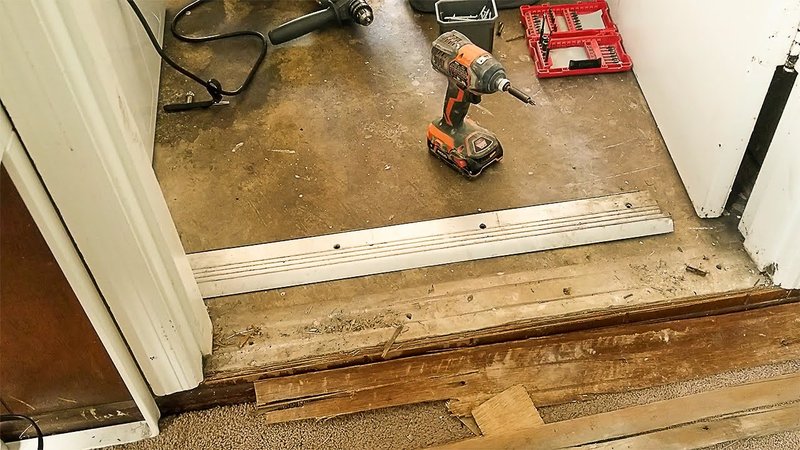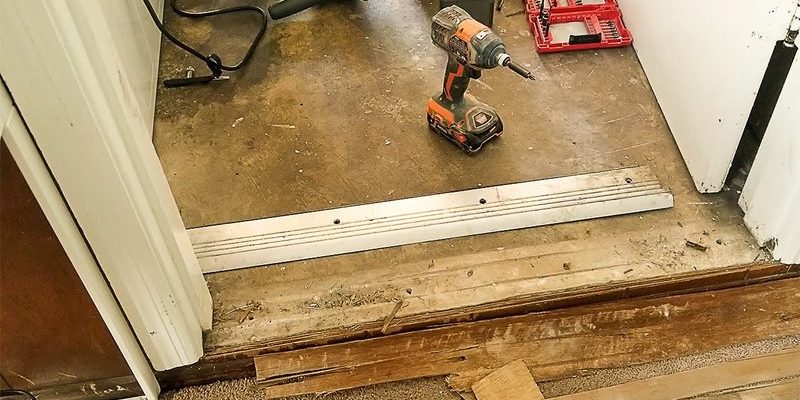
Let’s be honest, a leaky threshold isn’t just an annoyance. Over time, water sneaking under your door can mess with your floors, invite mold, and even rot out the subfloor or framing. Whether you’ve got a classic wood Craftsman door or a beefy steel unit with a Schlage smart lock, the brand or style doesn’t make you immune. This is a fixable headache, but you need to know where to look—and why it happens in the first place.
Why Do Exterior Door Thresholds Leak?
Here’s the thing: your door threshold is like the line judge in a tennis match. Its job is to keep outside and inside separate. But thresholds take a beating. Rainwater, melting snow, mud, and even the occasional stray leaf all pile up against it. If anything is off—maybe the threshold’s worn down, the door doesn’t seal tight, or the installer skipped an essential step—water finds its way through. Gravity, after all, is relentless.
Most folks don’t realize how much stress doors are under. From slamming shut to foot traffic, thresholds wear down slowly, sometimes almost invisibly. If you have a weatherproof sill (like a Pemko or Endura brand), that helps, but seals and gaskets still fail eventually. Even a small gap can channel water right under the door and onto your floor.
It’s worth mentioning: leaking thresholds aren’t always caused by just one big problem. More often, it’s a combination—like cracked caulk, a sagging door, and clogged weep holes. If you want to stop the leaks for good, you need to look for all the weak points, not just the obvious one.
Common Causes of a Leaking Door Threshold
If your exterior door threshold is leaking, there’s usually a culprit hiding in plain sight. Let me break down the most common reasons:
- Worn or missing weatherstripping: Over time, those soft rubber or foam seals break down or peel off, giving water a sneaky shortcut under the door.
- Improper threshold installation: If the threshold isn’t sloped away from the house or isn’t sealed tightly, it turns into a tiny water slide pointing at your floors.
- Cracked or missing caulk: Water loves to find gaps around the threshold. Dried-out or shrinking caulk leaves just enough space for leaks.
- Damaged or warped threshold: Wood thresholds, in particular, can bend or rot, pulling away from the subfloor and leaving a gap.
- Poor door alignment: If your door doesn’t close evenly or the latch is loose, wind-driven rain can squeeze right through those uneven spots.
You might be wondering: “Don’t fancy thresholds or smart doors avoid this?” Honestly, even top brands like Andersen or Pella can have issues if weatherstripping isn’t replaced or installers cut corners. Sometimes, the fix is as simple as a new bead of caulk. Other times, you may need to reset or replace the entire threshold.
How to Spot the Source of the Leak
Before you can fix a leaking threshold, you have to find out where the water’s coming in. Sounds obvious, right? But it can be trickier than you’d expect. Sometimes, water seeps in from the side jambs, or even wicks underneath from the subfloor. Here’s how to play detective:
- Look for water trails: After a heavy rain, check for dampness along the threshold, door corners, and floor edges. A flashlight helps spot fresh moisture on darker floors.
- Check the weatherstripping: Inspect all the seals around the door. Are they crushed, missing, or falling off? If you see daylight or feel a draft with the door closed, that’s a red flag.
- Test with a hose: If you’re still stumped, run water from a garden hose along the outside edge of the threshold and watch inside for any leaks. Go slow, and don’t flood the area—you want to mimic a hard rain, not a monsoon.
Sometimes the smallest crack lets in the most water. Go slow and check every inch—inside, outside, and even underneath if you can.
When you spot where the leak starts, you’ll have a much easier time fixing it, instead of just guessing and hoping for the best.
Weatherstripping Problems and Easy Fixes
Weatherstripping is one of those unsung heroes you forget about—until it fails. When your exterior door threshold leaks, this is often the first thing to go. Over time, constant opening and closing (not to mention dirt and grit) will flatten, tear, or peel the weatherstripping away. Even on a high-end door with a nice Schlage or Yale smart lock, if the seal is shot, water gets in.
Replacing weatherstripping isn’t hard. Here’s what you’ll need to do:
- Remove the old strip: Gently pull up on the damaged weatherstripping. Use a putty knife if it’s stubborn, but don’t gouge the door.
- Clean the area: Get rid of any old adhesive or gunk. A little rubbing alcohol or mineral spirits on a rag works wonders.
- Pick the right replacement: Take a sample of your old strip to the hardware store. Door brands aren’t always universal—some use special shapes, so match it closely. If in doubt, universal weatherstripping kits usually fit most doors, but check the thickness.
- Install and test: Press or slide the new weatherstripping into the groove and close the door several times to “set” it. Check for a tight seal with no visible gaps or daylight.
Sometimes, weatherstripping is only part of the problem. If you’ve replaced it and still see leaks, move on to the next trouble spot.
Threshold Alignment and Installation Mistakes
The threshold itself can be a major troublemaker if it wasn’t installed right—or if it has shifted over the years. Even a slight tilt toward the house (instead of away) sends water under your door every time it rains.
Let me explain: thresholds are designed with a slight slope to shed water OUT, not IN. If yours is flat or tilts the wrong way, gravity does the rest.
Here’s how to check for installation issues:
- Look for gaps: With the door closed, check for uneven spaces where the threshold meets the bottom of the door. Use a flashlight to check for any slivers of light sneaking through.
- Check slope direction: Place a small level on the threshold. The bubble should tip slightly away from the house. If not, you’ve got a problem.
- Resetting the threshold: If it’s loose, sometimes you can unscrew it, add some weatherproof caulk underneath, and reset it with a proper slope. Press firmly and retighten the screws, making sure everything sits flush.
Sometimes, an old wooden threshold is just too warped or rotted to save. In that case, swapping it out for a new aluminum or composite one (brands like Pemko, Endura, or even a universal kit) gives you a fresh start—and often a much better seal.
Caulking and Sealing for a Watertight Threshold
Even the best-installed door can leak like crazy if the caulking around the threshold fails. Think of caulk like the grout in your shower: it might seem boring, but it keeps everything sealed tight. When it cracks or shrinks away, water slips right in.
Here’s how you can fix this:
- Scrape away old caulk: Use a utility knife or a caulk remover tool to slice through dried-out caulk. Be thorough but gentle.
- Clean, dry surface: Wipe everything down with a damp cloth, then let it dry completely. Caulk won’t stick to damp or dirty spots.
- Apply new exterior-grade caulk: Choose a waterproof, paintable brand made for exterior use. Run a bead along every seam where the threshold meets the door frame and floor. Smooth it with your finger or a caulk tool for a neat finish.
- Let it cure: Don’t use the door for several hours or until the caulk is fully set. Check the label for dry times—it’s usually about 24 hours for a full cure.
New caulk usually solves minor leaks fast. But if you still see water coming through, you’ll need to check the threshold and subfloor underneath for hidden damage.
Dealing with Damaged or Worn Thresholds
Sometimes, a leaking exterior door threshold isn’t about the weatherstripping or caulk at all. If your door is old or the threshold looks beat up, you might be dealing with *structural* problems—rotted wood, corroded metal, or cracked composite. This is pretty common with wood thresholds, especially if your front porch doesn’t have an overhang.
Scan your threshold for:
- Soft spots or sponginess: Press down with your thumb. If it feels mushy, the wood underneath is probably rotting.
- Visible cracks, splits, or holes: Even tiny cracks can channel water inside. Aluminum or vinyl thresholds can dent or warp and leave gaps, too.
- Loose or wobbly movement: If the threshold moves when you step on it, the fasteners may have come loose, or the subfloor may be damaged.
If the damage is minor, sometimes you can seal it up with filler or replace just a small section. More often, though, it’s best to remove the old threshold and install a new, water-resistant one—ideally with a *built-in* weatherseal. Most universal threshold kits are pretty DIY-friendly and work with a range of common door brands.
When to Call a Pro (and What to Expect)
Honestly, most threshold leaks can be tackled by a confident DIYer—especially fixing weatherstripping or applying new caulk. But if you peel up the threshold and see mold, rotted subfloor, or any sign the leak has spread beyond the door, it’s smart to call a pro. Water damage can sneak up fast and get expensive if ignored.
A pro will:
- Check for deeper issues: Like rot in the framing, damaged flashing, or problems with the house’s drainage.
- Suggest replacement options: They might recommend swapping in a new, higher-quality threshold or adding extra flashing for good measure.
- Handle tricky installs: If your door is custom-sized or has a fancy lock system (like a Schlage smart lock), pros know how to work around those without messing up the fit or warranty.
If you’re handy and the damage looks minor, go ahead and try the basic fixes first. It feels good to solve it yourself! But don’t wait too long if you see bigger problems—water always wins in the end.
Finishing Touches: Keeping Your Threshold Leak-Free
Think of threshold maintenance like flossing your teeth—easy to skip, but one small effort saves a lot of headaches. Every year or two, take five minutes to check the seals, weatherstripping, and caulk around your exterior doors. Even if you’ve just fixed a leak, keep an eye on it for any new signs of trouble, especially after heavy storms.
If your door threshold has a removable gasket, pop it out and inspect it for wear. Wipe down the area to keep dirt and sand from grinding away at the moving parts. And if you notice your lock isn’t syncing or your smart remote system needs a reset after fixing leaks (sometimes water intrusion can mess with the electronics), don’t ignore those warning signs—humidity can affect door electronics just as much as your wood and metal.
By keeping up with these simple checks, you’ll save yourself from bigger repair bills down the line—and keep your floors dry, your entryway looking sharp, and your home feeling secure.
So, next time you see that puddle by the door, you’ll know it’s not just a nuisance—it’s a clue. With a little troubleshooting, the right tools, and a bit of patience, you can kick threshold leaks to the curb and keep your home protected for years to come.
